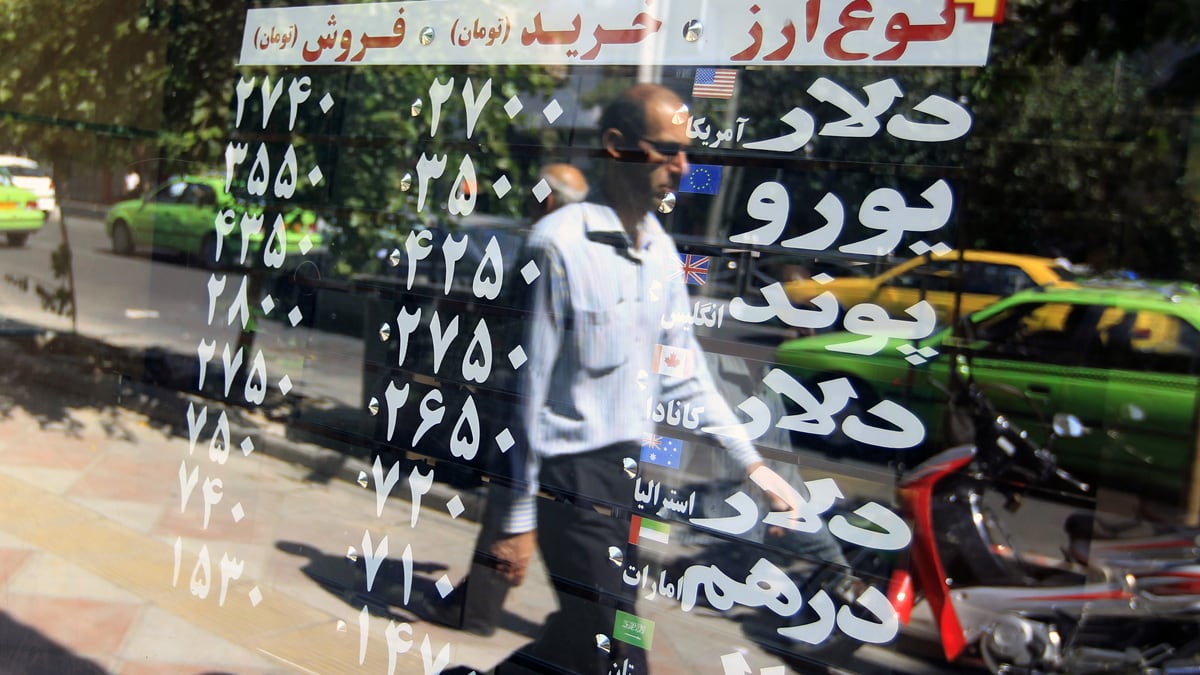Thursday night Barack Obama and Mitt Romney generally agreed that the economic sanctions imposed against Iran were hurting the country’s economy. And it does indeed seem as if the American dollar and American-led financial diplomacy are inflicting a good deal of damage.

The value of the Iranian rial has plummeted in the past year, reaching new lows in October as sanctions and economic malaise have drained away exports. Steven Hanke, an economist at Johns Hopkins University, has been poking around Tehran’s black-market bazaars. And he says that Iran’s monthly inflation rate is now as high as 70 percent. In Iran, prices now rise more in a day than they do in the U.S. in an entire year. That’s officially hyperinflation, which renders everyday goods unaffordable. In Iran, at that 70 percent rate, everything becomes twice as expensive every six weeks.
Officially, the Iranian government will give normal Iranians 12,260 rials for one American dollar, Hanke wrote in the November issue of Globe Asia. Iran’s exchange rate is fixed, set by the nation’s central bank. Since the inflation hit, “official dealers”—that is, friends of the regime—have received a better rate: 25,480 rials, straight from the Iranian Central Bank. But both rates are a fantasy. On the black-market, Iranian moneylenders peg the real exchange rate far higher, at more than 35,000 rials per dollar. And it is rising fast: 100, 200, and 500 rial notes are now pretty much useless, Hanke reports. If that’s your change, an Iranian shopkeeper will give you a small pack of gum instead.
It’s the Middle East’s first-ever bout of hyperinflation, and there’s much money to be made (or saved) in foreign currency. But in Iran, getting greenbacks is a dangerous business. Ahmadinejad has sent scores of police into Tehran’s dusty bazaars, hunting down and arresting currency traders. Ayatollah Khomeini says these ad hoc FOREX gurus are abetting an international “conspiracy” that will hasten the republic’s economic doom. The government has branded the dollar-changers Iran’s “invisible mafia.”
But Iranian hyperinflation is no conspiracy. It’s simple economics. Since Ahmadinejad can’t export nearly as much oil as he could before the sanctions, he can’t get his hands on nearly as many dollars. And so scarce dollars have seen their value rise sharply against the rial. Unfortunately, according to Hanke, the rial is now the least sought-after currency in the world, falling below the Vietnamese dong in late September. Internationally, there’s practically no demand for the rial—because there’s no (legal) demand for the Iranian oil it buys.
Moreover, the trickle of oil that the regime can get away with exporting is very difficult to sell, since any bank that processes an Iranian payment is liable to charge huge fines for breaking the global banking embargo. (To be clear, it’s not as if the rial floated freely before the ban; then, Iran’s central bank regularly manipulated exchange rates by flooding or starving the domestic market with its vast supply of petrodollars.) Global enforcement of the financial firewall has been particularly strong—no surprise, as Iran chest thumping is one of the few American foreign-policy issues that voters seem to care about. Standard Chartered, a major British bank, paid a $340 million settlement after admitting that 300 of its Iranian transactions broke the rules.
Hyperinflation is our clearest economic evidence yet that the sanctions are working. Before they were implemented in June 2010, Iran’s monthly inflation rate was 0.7 percent. The upshot: the average Iranian is miserable—and getting twice as poor every 40 days.
The implications of Iranian hyperinflation for American policy are less clear. The New York Times reported last weekend that the U.S. and Iran had agreed to post-election nuclear talks—which might imply, as Sen. Dick Durbin said, that the currency crisis is forcing Ahmadinejad’s hand. (Both governments denied the report.) But Amir Mohebbian, an Iranian writer for Ayatollah Khamenei’s official website, wasn’t buying it. “As long as the U.S. makes threats and creates sanctions against us,” he said, “no negotiations will be endorsed by our supreme leader.”
Can economic angst topple a despot? As the president put it in last night’s debate, “We organized … the strongest sanctions against Iran in history, and it is crippling their economy. Their currency has dropped 80 percent … And the reason we did this is because a nuclear Iran is a threat to our national security.” Mitt Romney basically—and predictably—agreed, saying “It's absolutely the right thing to do, to have crippling sanctions. I would have put them in place earlier.” Both are betting that the sanctions and currency crush is the best way to avoid war, stop the centrifuges, and usher out Ahmadinejad.
But one other Middle Eastern nation ground out nearly a decade of painful inflation under American-led sanctions: Iraq. Enacted in 1990, those financial and trade barriers wrought 12 years of humanitarian misery—and at the close, we still went to war. “Containing” Saddam in economic isolation was, in the words of Council on Foreign Relations fellow Walter Russell Mead, one of “the costliest failures in the history of American foreign policy.” Saddam didn’t fall, but grew stronger. Extremism didn’t wane, but grew fiercer. The independent middle class, once thought the key to reform, withered away as their businesses collapsed. And when it came to our safety, none of that seemed to matter. Then, as now, it was thought that even the leader of an impoverished, currency-slammed land could marshal enough money to go nuclear.





